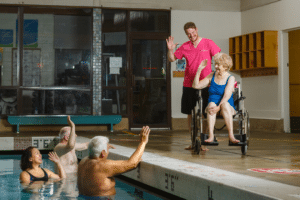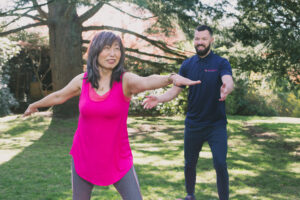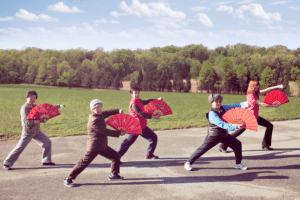The Benefits of Group Exercise for Seniors
As the aging population grows, the focus on holistic health and well-being becomes paramount. Group exercises offer a unique intersection of physical activity and social engagement, proving essential for seniors.
The myriad benefits of exercise groups for seniors don’t just encompass physical health improvements. These communal sessions offer opportunities for seniors to foster social connections, elevate their mental well-being, and enhance functional abilities that are pivotal for daily life. And that’s where Nurse Next Door steps in, bridging the gap and ensuring that seniors have access to these transformative group exercises in the most supportive and efficient way.

Four Key Benefits of Group Exercise for Seniors
The modern-day understanding of health goes beyond just physical well-being. Especially for seniors, a multifaceted approach that also emphasizes mental health, social activities, and daily life functionalities can make a significant difference. Let’s delve into these benefits:
🌼 Physical Health Boost
Active participation in group fitness classes and group-based exercise programs can be invaluable for a senior’s physical health. Such sessions foster heart health, amplify muscle strength, and enhance flexibility. Regular involvement not only aids in maintaining an optimal body composition but also fortifies the defenses against chronic diseases. As various studies in sports medicine and public health suggest, “exercise is the best medicine,” and its consistent inclusion in daily life ensures that older adults can savor a life rich in vitality and well-being.
🌼 Enhancing Mental and Physical Health & Wellbeing
The connection between physical activity and mental health is undeniable. Engaging in group fitness classes offers seniors more than just a physical challenge. It stimulates cognitive function, promoting mental agility. Additionally, the shared experience of group exercise combats feelings of loneliness and fosters a sense of achievement. With every session, seniors not only fortify their muscles but also nourish their minds.
🌼 Strengthening Social Connections
In an age where many older adults often feel isolated, group exercises emerge as a beacon of social support. These sessions provide seniors with a unique space to connect, share, and build bonds. It’s more than just fitness; it’s about belonging to a community that cheers for each member’s success and lends a hand during challenges.
🌼 Improvement in Functional Abilities
Daily life is composed of countless small tasks that, over time, may pose challenges for seniors. Thankfully, group exercises, when done consistently, can significantly enhance functional ability. Activities that once seemed daunting—like carrying groceries or enjoying a playful moment with grandchildren—become more accessible, ensuring seniors can embrace the joy of independent living.

Types of Group Exercises Suitable for Seniors
As we recognize the importance of physical activity interventions for the aging population, it becomes clear that older adults need a personalized approach to exercise. Their distinct needs and physical challenges mandate particular workouts that strike the balance between safety and effectiveness. Below, we delve into a curated list of group exercise programs that cater to the senior demographic, ensuring they not only improve strength but also feel connected and motivated.
Low-Impact Aerobics
Low-impact aerobics, often a favorite in group fitness classes, offer seniors a revitalizing cardiovascular workout without undue stress on their joints. Exercises like walking routines, chair aerobics, or dance classes to classic tunes provide ample opportunities for seniors to elevate their heart rates and enjoy the myriad benefits of regular physical activity in a supportive group setting.
Strength Training
Addressing the inevitable muscle deterioration that comes with age, strength training stands as a cornerstone in the realm of senior fitness. Through routines involving free weights, resistance bands, or even body-weight exercises like squats and lunges, older adults can effectively combat age-induced muscle loss. These sessions, backed by sports medicine insights, provide the necessary impetus to keep seniors functionally independent in their daily lives.
Balance and Flexibility Routines
The risk of falls, a common concern among many older adults, underscores the value of balance and flexibility workouts. Embracing exercises like balance beams, heel-to-toe walks, and various stretches, these routines offer dual benefits: they bolster physical agility and foster a renewed self-efficacy among seniors. The resultant improved mental and physical health aids them in moving confidently in their surroundings.
Senior Fitness Classes
Tailored specifically for the aging adults, senior fitness classes transcend mere workouts. They serve as community hubs where older adults engage, share experiences, and draw social support. With offerings ranging from senior yoga and Pilates to tai chi and aqua aerobics, these classes, often underpinned by health education principles, ensure that every participant, regardless of their fitness level, reaps the health and well-being benefits while feeling a sense of belonging.

Initiating and Maintaining Group Exercises for Seniors
For many seniors, the thought of starting a new exercise regimen can be both exciting and daunting. It’s not just about finding the right exercise; it’s also about maintaining the enthusiasm and ensuring longevity in the routine. This section provides a roadmap for those aiming to seamlessly integrate group exercises into a senior’s daily routine and make it a lasting, enjoyable habit.
Steps to Start Group Exercises
- Assess Fitness Levels: A foundational step is to get a clear picture of a senior’s physical condition. Regular health check-ups and assessments give insights into strengths and areas of caution.
- Seek Professional Guidance: It’s always prudent to get a nod from healthcare providers. A physician or a certified senior fitness instructor can offer invaluable advice on the most appropriate exercises and safety precautions.
- Choose a Suitable Program: Not all exercises resonate with everyone. Based on preferences, medical history, and individual goals, find a program that sparks joy and feels right.
- Start Slowly: Patience is paramount. Beginning with gentler exercises and shorter durations ensures the transition into regular workouts is smooth and injury-free.
Tips to Maintain Consistency and Safety
- Routine is Key: Just like taking morning medications or watching a favorite evening TV show, make exercise a non-negotiable part of the day. This consistency builds momentum and forms a lasting habit.
- Stay Hydrated: As workouts can lead to dehydration, especially in older adults, ensure a steady intake of water keeps the body nourished and fatigue at bay.
- Wear the Right Gear: Simple things, like wearing non-slip shoes or moisture-wicking attire, can significantly elevate the exercise experience and reduce risks.
- Listen to the Body: Above all, it’s essential for seniors to be attuned to their body’s signals. Recognizing any discomfort or strain early can prevent potential complications.
- Join a Group: A community feeling often acts as a motivational boost. Being part of a group fosters accountability, provides social interaction, and makes the fitness journey more enjoyable.

How Nurse Next Door Can Aid in Happier Aging™ Through Group Exercises
As the aging population grows, the quest for improved mental and physical health becomes paramount. Group exercise has emerged as a beacon of hope, offering a slew of benefits that harmonize with the philosophy of Happier Aging™. At the heart of this movement is Nurse Next Door, bridging the gap between the need for regular physical activity for older adults and the practicalities of accessing and participating in such programs.
Seamless Transportation Solutions
For many older adults, the logistics of reaching group fitness classes or group-based exercise programs can be a significant deterrent. Recognizing this, Nurse Next Door offers impeccable transportation solutions. This not only ensures regular exercise for seniors but also eliminates the hassle, helping them focus solely on their health and well-being.
Companionship and Support
Isolation can dampen enthusiasm, especially in an exercise setting. But, with Nurse Next Door, seniors aren’t alone. A dedicated companion offers not just practical help but also emotional support. Such camaraderie fosters self-esteem, encourages consistency, and elevates the overall group exercise experience, making it align closely with the principles of social support and well-being.
To Wrap Up!
Physical exercise, when intertwined with social activities, emerges as a potent formula for enhancing the life of seniors. It’s not just about maintaining physical health; it’s about forging connections, boosting mental health, and enriching daily lives. Nurse Next Door embodies this mission, making group exercises accessible, enjoyable, and above all, a pathway to Happier Aging™.
Pondering over introducing group exercises to your senior family members? Need advice or support? Our dedicated team at Nurse Next Door is ever-ready and just a call away, anytime, at 1-877-588-8609.

